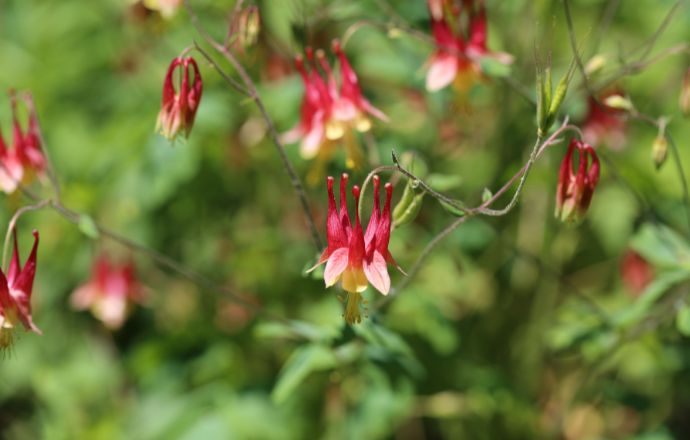[Updated February 16, 2023] Western North Carolina is truly stacked with natural beauty.
From the misty hills of the Blue Ridge Mountains and the towering trees of Pisgah National Forest to the countless waterfalls scattered throughout the area, it’s easy to find yourself awestruck by the scenery that greets you nearly every which way you turn.
Though North Carolina’s Fall colors may make autumn the most popular time to visit the region, spring is also a special time for spotting a dazzling array of NC wildflowers.
Whether you’re trekking North Carolina mountain hiking trails or exploring overlooks along the Blue Ridge Parkway, visitors to my home state can spot dozens of wonderful wildflower species from March through midsummer.
Though it’s pollinators these beauteous blooms are hoping to attract, we get to reap the benefits as well.
And while seeing their Crayola-like palette of colors offers its own rewards, learning a bit about these flowers can provide a deeper sense of enjoyment.
With that in mind, check out our guide to North Carolina wildflowers and flowering trees, which includes some of the top spots in the Western NC mountains for seeing them up close.
READ MORE: The 10 Hiking Essentials Packing List for the Blue Ridge Mountains

North Carolina Wildflowers Guide
- Trillium (Trillium spp)
- Jack-in-the-Pulpit (Arisaema triphyllum)
- Creeping Phlox (Phlox spp)
- Trout Lily (Erythronium umbilicatum)
- Fire Pink (Silene virginica)
- Dwarf Crested Iris (Iris cristata)
- Bloodroot (Sanguinara canadensis)
- Ironweed (Vernonia noveboracensis)
- Wild Bergamot/Bee Balm (Monarda fistulosa)
- Cardinal Flower (Lobelia cardinalis)
- Pink Lady’s Slipper (Cypripedium acaule)
- Swamp Milkweed (Asclepias incarnata)
- Wild Columbine (Aquilegia canadensis)
- Wild Geranium (Geranium maculatum)
- Turk’s Cap Lily (Lilium superbum)
- Black Cohosh (Actaea racemose)
- Flowering Dogwood (Cornus florida)
- Catawba Rhodendron (Rhodendron catawbiense)
- Mountain Laurel (Kalmia latiflolia)
- Flame Azalea (Rhododendron calendulaceum)
- Eastern Redbud (Cercis canadensis)
- Southern Crabapple (Malus angustiflolia)
- Serviceberry (Amelanchier spp.)
- Witch Hazel (Hamamelis virginiana)
- Black Cherry (Prunus serotina)
READ MORE: The 10 Best Things to Do in Winston Salem NC

1. Trillium (Trillium spp)
There are more than three dozen species of trillium that are native to North America, and the North Carolina mountains are hotbeds for them.
Trilliums like to grow in shady spots with rich humus (or organic soil).
They’re beloved for their flowers, which characteristically have three petals and three bracts (specialized leaves that help with reproduction).
These low-lying plants are very popular. But they grow slowly, taking up to seven years to reach maturity and often falling victim to hungry deer.
Spotting them in the wild is a real treat, and the flowers come an assortment of colors, from deep burgundy to white to golden to pink.
READ MORE: The 52 Best Hikes in North Carolina for the 52 Hikes Challenge

2. Jack-in-the-Pulpit (Arisaema triphyllum)
Jack-in-the-pulpit grows in woodlands, preferring a shady environment with plenty of moisture and organic matter (such as a forest floor).
The hermaphroditic plant grows to between one and two feet tall and tends to grow in colonies.
The mature plants produce a cluster of red berries in late summer.
The flowers of the Jack-in-the-pulpit look more like something we’d associate with the tropics.
They have a large, vase-like base (the female part of the bloom), with a dainty lid folding over the top of it (the male part).
These flowers are usually striped, with a tendency towards greens and purples. Once you spot one, be on the lookout for more!
READ MORE: The 27 Best Waterfalls Near Asheville, NC

4. Trout Lily (Erythronium umbilicatum)
The perennial trout lily is a spring ephemeral, meaning that it grows, flowers, and dies back quickly in the spring, disappearing until the next spring rolls around.
These peculiar plants grow in woodland areas, either in partial or full shade, and tend to congregate near ponds or streams, where the moisture level is fairly constant.
They grow from small white bulbs that multiply into colonies of individual trout lily plants.
Each one has two mottled leaves and a single stem with a yellow flower resembling, you guessed it, a lily.
Trout lilies get their fishy first name from their leaves. They have a smooth, fleshy appearance suggestive of the trout swimming in the streams that these flowers grow along.
READ MORE: The 20 Best Western North Carolina Waterfalls for Hiking

5. Fire Pink (Silene virginica)
Neither large nor particularly abundant, the fire pink is a noteworthy wildflower because it has a striking red color that stands out starkly against the forest floor.
The five petals of the fire pink are narrow and about half an inch long, and each of the dainty flowers burns brightly.
Fire pinks are short-lived perennial plants, lasting only a couple of years.
They can grow up to two feet tall, and they like rocky slopes in open forests.
The fire pink is primarily pollinated by the ruby-throated hummingbird (which, like all hummingbirds, is highly attracted to the color red).
Ruby-throated hummingbirds are commonly seen birds in North Carolina during the summertime.
READ MORE: The Best Things to Do in Hendersonville NC

6. Dwarf Crested Iris (Iris cristata)
Another low-lying wildflower that can work well as a groundcover in shady spots, the dwarf crested iris is native to North Carolina and a miniature version of the iris proper.
Dwarf crested irises like to live in rocky areas and woodlands. They get no taller than nine inches, and will only bloom in rich (but not too rich), well-drained soil.
These tiny irises can come in a variety of colors, including blue, white, yellow, pink, and purple.
They’re great for attracting pollinators such as hummingbirds and bumblebees.
These flowers have all the panache necessary for cultivated gardens, but they also have the hardiness and resistance to nibbling deer that a common wildflower needs.
READ MORE: The 15 Best Things to Do in Banner Elk NC

7. Bloodroot (Sanguinara canadensis)
Bloodroots love to grow on forest floors where the soil is moist and nutrient-rich, and they’re widely distributed in most states east of the Mississippi River.
The bloodroot gets its morbid name from the fact that the flower rhizome (underground stem) secretes a blood-red liquid when damaged.
The flower’s leaves are singular, with oddly lobed edges.
The flowers are white, with anywhere from 6 to 18 petals surrounding yellow centers.
Though toxic to ingest, bloodroot has been used medicinally for centuries, and the rhizomes are still used to create natural dyes today.
READ MORE: The 15 Best Things to Do in Blowing Rock NC

8. Ironweed (Vernonia noveboracensis)
What a wonderful realization to have when we discover that so many “weeds” are actually beautiful flowers, just persistent enough to show up in droves.
Ironweed is a stunning perennial wildflower that readily makes itself at home in most circumstances. But it especially loves to settle in rich, acidic soils, such as the borders of wetlands.
The herbaceous plant can grow to be eight feet tall, and it has showy purple flowers that appear in clusters between July and September.
In addition to being beautiful and native to North Carolina, ironweed is deer-resistant, good for pollinators, and easy to grow, so it makes a good addition to gardens.
READ MORE: The 10 Best Lakes in the North Carolina Mountains to Visit

9. Wild Bergamot/Bee Balm (Monarda fistulosa)
Part of the illustrious and wide-ranging mint family, wild bergamot or bee balm (both terms are used for several similar plants) are both aromatic and beautiful.
Like most types of mint, bee balm is prone to spreading in wide clumps and taking over a space. But it is much larger and has much more prominent flowers than the mints we tend to think of.
Bergamot is capable of growing up to four feet tall. And depending on the species, it puts on a dazzling display of either red or purple flowers.
These plants tend to grow in drier soils and can be found along roadsides, in unkempt fields, and along forest margins.
READ MORE: The Top 25 Blue Ridge Mountain Towns in GA & NC

10. Cardinal Flower (Lobelia cardinalis)
As its name suggests, the cardinal flower has a flaming red bloom. But the “cardinal” in the flower’s name is in reference to the red robes of Catholic cardinals rather than the birds.
A type of lobelia, the cardinal flower has been named Wildflower of the Year in North Carolina three times, an honor designated by the North Carolina Botanical Garden.
Cardinal flowers grow to be about four or five feet tall, and their vibrant red flowers show up in late summer and hang around into the middle of fall.
The best place to spot cardinal flowers is in wetlands or along the banks of streams and ponds. They need wet soil to survive, but they can tolerate a bit of shade.
READ MORE: The Best Hiking in Asheville NC Bucket List (Top 25 Hiking Trails)
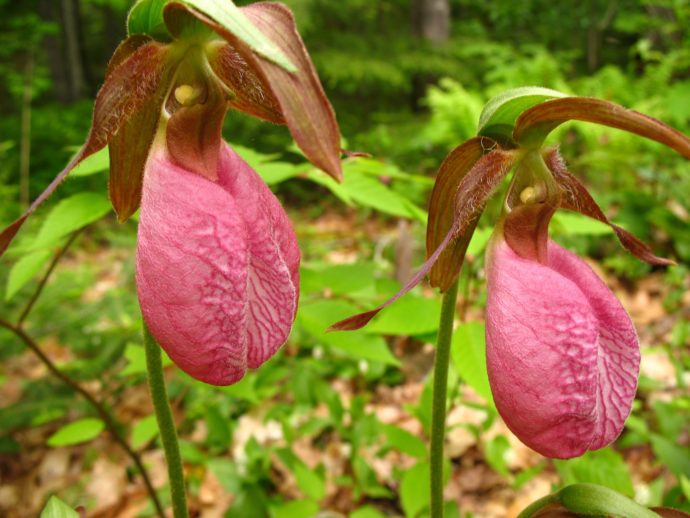
11. Pink Lady’s Slipper (Cypripedium acaule)
Also known as the Moccasin Flower, the Pink Lady’s Slipper is considered an NC Significantly Rare species. Although not classified as endangered, climate change and human encroachment threaten this lovely orchid’s future in the wild.
They are one of North Carolina’s largest native orchids, growing up to 15 inches tall.
These fantastic flowers bear a beautiful pink inflated petal, with darker veins running along the surface.
Pink Lady’s Slippers form a symbiotic relationship with a soil fungus that is crucial to their growth. Without it, they would wither away after three to five years, but with it they can live up to 20 years!
If you’re lucky, you may come across several hundred of these flowers within a small area while hiking the Blue Ridge Mountains of North Carolina.
READ MORE: The 7 Best Hikes on the Appalachian Trail in North Carolina
12. Swamp Milkweed (Asclepias incarnata)
Otherwise identified as Swamp Butterfly Weed or Marsh Milkweed, Swamp Milkweed is a perennial member of the dogbane family.
It grows in all regions of North Carolina, from the Mountains and Piedmont all the way to the NC Coast.
Swamp milkweed’s preferred habitat is near wetlands, along stream banks, and in meadows.
This plant grows up to 5 feet tall and blooms from late spring to early autumn, with flowers in pinkish clusters.
They’re mildly toxic to humans, and are known to be problematic for pets and some wildlife that ingest it. However, the plant is an integral food source for the Monarch butterflies’ caterpillars.
READ MORE: The 20 Best Places to Visit in North Carolina
13. Wild Columbine (Aquilegia canadensis)
The Latin name of Wild Columbine, Aquilegia, refers to the appearance of the back of the plant’s blooms. The word means eagle, and the back of the flowers resembles a raptor’s claw.
Wild Columbine likes a bit of shade, and is native to the forest floor.
It’s a great ground cover, as it self-seeds prolifically, and it is also a perennial plant, returning year after year.
The plants can reach up to three feet tall, and the flowers are red or yellow, tubular, and face downwards. They bloom in early spring, and the flowers typically last about a month.
Wild Columbine is attractive to butterflies, bumblebees, and hummingbirds, as well as people. It’s a lovely NC wildflower to spot.
READ MORE: The 10 Best North Carolina Mountain Resorts to Visit
14. Wild Geranium (Geranium maculatum)
There are two species called cranesbill and/or “Wild Geraniums” that are native to North Carolina: Geranium maculatum and G. carolinianum.
They are both perennial flowers that enjoy the woodlands (particularly woodland fields) and somewhat dry soils.
Wild Geranium is multi-branched and only grows to about a foot tall, spreading out roughly the same.
These plants have beautiful blooms of blues, purples, pinks, reds, and whites, and attract lots of pollinators.
Wild geranium also has edible qualities. In the Blue Ridge Mountains, both the leaves and rhizomes (root-like stems) have historically been used for making medicinal teas.
READ MORE: The 15 Best Romantic Getaways in NC (Cabins, Inns & Resorts)
15. Turk’s Cap Lily (Lilium superbum)
Turk’s Cap Lily grows in partial shade in deep, fertile soil. It likes moist areas like bogs, ravines, swamps, and forest coves.
This beautiful flower can grow up to 8 feet tall, with blooms forming in clusters on spindly stems. Its flowers tend to be orange or yellow, with some purple specimens as well.
The Turk’s Cap Lily has the notable characteristic of six vibrant petals that bend back towards the flower head. They bloom mostly in summer, especially July and August.
Considered one of the easiest NC native wildflowers to cultivate at home, this bulb plant grows throughout the state.
READ MORE: The 15 Best Campgrounds in the North Carolina Mountains
16. Black Cohosh (Actaea racemose)
A mainstay wildflower in the Eastern US, from Maine to southern Georgia, Black Cohosh is a woodland flower that enjoys lots of shade.
It can grow to heights of 6 feet if shielded from the wind, and it can be a great backing border for busy cottage gardens.
These white flowers form in oblong clusters on spike-like stems, and they have a medicinal odor that some people consider unpleasant.
As alluring as the flowers themselves may be, the seed heads of Black Cohosh (which form in late summer) are notable enough to be featured in flower arrangements.
READ MORE: The 15 Best Things to Do in Great Smoky Mountains National Park
North Carolina Flowering Trees

17. Flowering Dogwood (Cornus florida)
What better flowering tree to start off the wildflower list than the flowering dogwood, the official North Carolina State Flower!
Flowering dogwoods are deciduous trees that normally range between 15 and 25 feet tall.
They often grow at the edges of forests, where the sun is a little more available.
Ironically, the “flowers” for which dogwoods are so highly regarded are actually white (or sometimes pink) bracts that appear as the backdrop of the demonstrably less stunning and tiny green flowers.
Whatever the case, a flowering dogwood in bloom is a specimen to behold, and they are common throughout Western North Carolina.
READ MORE: The Best Downtown Asheville Restaurants

18. Catawba Rhodendron (Rhodendron catawbiense)
One of many local members of the rhododendron genus found in North Carolina, the Catawba rhododendron is a broad-leafed, evergreen shrub that enjoys life in the forest understory.
North Carolina’s Blue Ridge Mountains are famous for playing host to this plant, and specifically for the stunning pink and purple flower displays they put on each spring.
Unlike other members of its huge botanical family—including blueberry, huckleberry, and cranberry— the rhododendron is highly toxic if ingested.
Nevertheless, residents and visitors alike appreciate looking at them every spring.
The shrubs typically grow to about ten feet tall, and the flowers have a funnel shape and appear in large clusters.
READ MORE: The 20 Best Treehouse Rentals in the North Carolina Mountains

19. Mountain Laurel (Kalmia latiflolia)
Another broad-leafed evergreen that is partial to the Appalachian Mountains, mountain laurel is a relative of rhododendron and ranks among the most stunning flowering trees in North Carolina.
Like rhododendron, mountain laurels are multi-stemmed shrubs with gnarly trunks and alluring clusters of flowers (these being white and pink) that come out in early spring.
Mountain laurel likes growing in dappled shade beneath larger overstory trees like oak and poplar, and often grows in thickets that are too dense to navigate.
It is one of the many spring flowers you can see along the Blue Ridge Parkway, or beside countless NC hiking trails.
READ MORE: The 20 Best Pisgah National Forest Hiking Trails in North Carolina

20. Flame Azalea (Rhododendron calendulaceum)
We could go on and on about the gorgeous Ericaceae family of flowering plants, and the Rhododendron genus in particular.
But we’ll move on after one of its most stunning members, the flame azalea.
A very similar plant to Catawba rhododendrons and mountain laurels, the flame azalea is a smaller shrub with a cool-looking trunk and broad, evergreen leaves.
Where it differs notably is the wonderful red, orange, and yellow flower clusters it imparts each spring.
They’re so vibrant and colorful, it’s easy to see why they were compared to candle flames.
The flame azalea loves mountain slopes covered in woodlands, with a mix of sun and shade hitting the forest floor.
They are around, but a little more difficult to find than some of the other wildflowers on this list.
READ MORE: The 15 Best Things to Do in Burnsville NC

21. Eastern Redbud (Cercis canadensis)
Eastern redbuds are small trees that grow wild throughout Western North Carolina.
In the early spring, their bright pink blooms make them very easy and rewarding to spot.
Before leafing out, clusters of small blooms cover the bare branches of the redbud tree, making the amazing burst of color all the more eye-catching.
Once you learn to identify them, they are obviously everywhere. They’ll often be the most visible part of the forest in March.
Though mostly noted for its flowers, which are edible and delicious, the Eastern redbud also has attractive, heart-shaped leaves that show off in the summertime.
READ MORE: The Best Things to Do in DuPont State Forest, NC

22. Southern Crabapple (Malus angustiflolia)
The often disrespected, wild cousin of North Carolina orchard apples, southern crabapple trees more than make up for their smallish fruit with their brilliant white-pink flowers.
A shrub-like tree that usually tops out at around 30 feet tall, the southern crabapple likes pine or mixed forests with enough sun and space for them to spread their leafy crowns.
The fruit of crabapple trees is edible and commonly used for jams and cider.
But in these days of supermarket produce aisles, the flowers are typically considered the prize on these trees.
Like many smaller trees, these are best spotted along the edges of established forests, and they’ll often appear in abundance when present.
READ MORE: How to Get to Crabtree Falls Near Little Switzerland NC
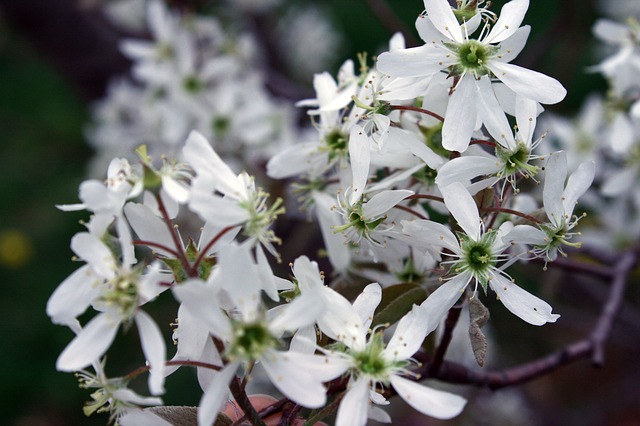
23. Serviceberry (Amelanchier spp.)
There are a number of serviceberry species that are native to North Carolina.
All of them are noted for their early white blooms, which often appear even before the redbuds and dogwoods.
Also known as juneberry and shadbush, these flowering trees produce edible berries (roughly the size of blueberries) that are great for attracting and feeding wildlife.
Different varieties can be found throughout the state, and they are noted for being drought-tolerant and spreading (via root suckers) into colonies.
The name serviceberry comes from the fact that the flowering of the plant signals that the ground has thawed, and thus is suited for burying the dead (i.e. a funeral service).
READ MORE: The 15 Best Things to Do in Boone NC (Blue Ridge Parkway MM 291.8)

24. Witch Hazel (Hamamelis virginiana)
For those who have used witch hazel from the pharmacy, this is the tree that provides the magic.
The North Carolina native grows to about 15 or 20 feet tall, with unusual flowers.
They’re lacy and yellow, forming loose hanging pompoms, and they don’t flower until late autumn or after.
So they’re best to spot on Winter hikes, where they really stand out against the landscape. They like to grow at forest edges and along stream banks.
Aside from NC, witch hazel grows from Florida to Quebec. So they’re good ones to keep in mind when you’re looking for wildflowers in Virginia or elsewhere along the East Coast.
READ MORE: The 10 Best Blue Ridge Parkway Hotels & Cabin Rentals in NC
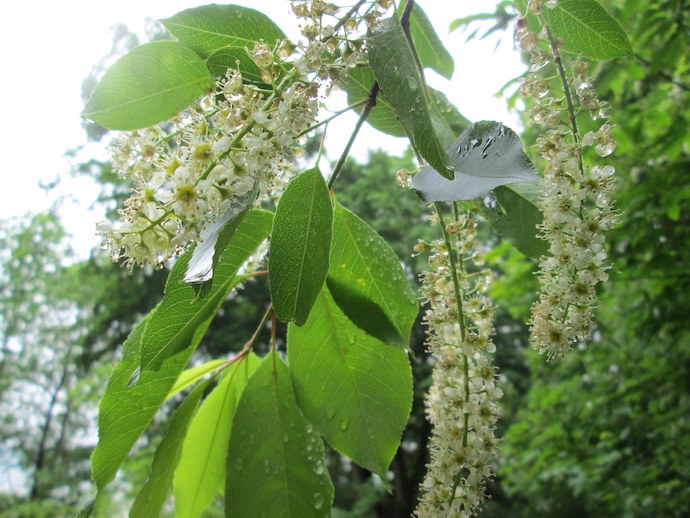
25. Black Cherry (Prunus serotina)
Known as black cherry or wild cherry, these are big native North Carolina trees that can reach up to 80 feet tall.
They are found throughout the state of North Carolina, but like mountain life the most.
Like other cherry trees, black cherry trees put out early spring blooms that help to brighten up the forest after all those months of snow.
Despite being highly toxic in many areas (including its bark, roots, and leaves), the dark purple fruits produced in late summer are 100% edible.
The toxins in the black cherry tree are cyanogenic– the same as found in almonds– so the bark and crumpled Autumn leaves have the pronounced aroma of almonds.
READ MORE: The 15 Best Things to Do in Elkin NC (Blue Ridge Parkway MM 229)
Best Wildflower Hiking Trails in Western North Carolina

Oconaluftee River Trail (Great Smoky Mountains National Park)
This is one of the many fantastic wildflower hikes in Great Smoky Mountains National Park, which straddles the border between North Carolina and Tennessee.
The Oconaluftee River Trail is a 3-mile, out-and-back hiking trail, with an abundance of trillium and Jack-in-the-pulpits along the way.
The trail is located just outside of Cherokee NC, and, of course, moves alongside the Oconaluftee River.
READ MORE: The Cataloochee Valley Elk in Great Smoky Mountains National Park

Graveyard Fields Loop (Blue Ridge Parkway)
The Graveyard Fields Loop is a 6-mile looping trail that can be accessed via the Blue Ridge Parkway at Milepost 418.8.
The trail is not far from downtown Asheville breweries, and it’s one of the most popular places for day trips from the city.
The high, flat mountain valley sits at over 5,000 feet. It’s famed for its waterfalls, blueberries, black bears, rhododendron, and mountain laurel, to name but a few.
READ MORE: The 15 Best Blue Ridge Parkway Waterfalls in North Carolina

Craggy Pinnacle Trail (Blue Ridge Parkway)
There are a series of Craggy Mountain stops along the Blue Ridge Parkway, including Craggy Gardens.
The Craggy Pinnacle Trail is famed for both its wildflowers in the spring and its 360º views of the Appalachian Mountains.
On the roughly one-mile trek, there are tunnels through Catawba rhododendron thickets, as well as lots of blackberries, blueberries, and wildflowers along the way.
READ MORE: The 15 Best Blue Ridge Parkway Hikes for NC Day Trips

Pink Beds (Pisgah National Forest)
A healthy 5-mile trek through Pisgah Forest, the Pink Beds Trail is heavily trafficked despite its length.
It is a relatively flat walk through high-elevation meadows, over babbling creeks, and atop mountain bogs, yielding a stunning array of wildflowers in late spring (particularly mountain laurels and rhododendron).
The trailhead is not far from the Blue Ridge Parkway on Highway 276, just a little north of the Cradle of Forestry. It crisscrosses the South Fork Mills River.
READ MORE: The 15 Best Pisgah National Forest Waterfalls to Explore
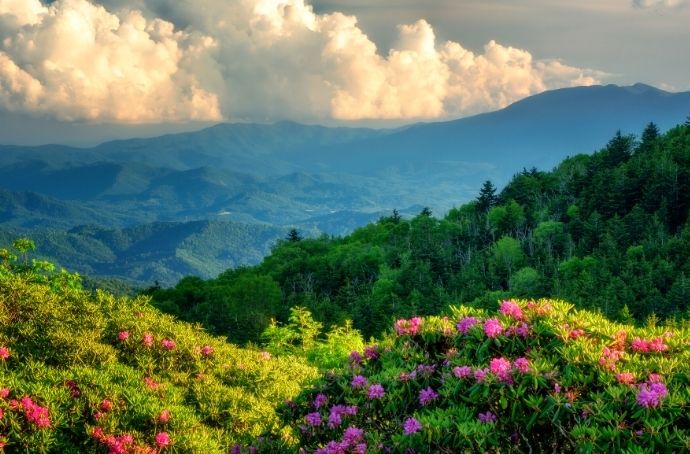
Appalachian Trail (From Carvers Gap to Roan Highland)
While the 2,200-mile Appalachian Trail has more than its fair share of wildflower fields, the high mountain balds near Carvers Gap simply have to be ranked amongst the best.
Not only do they offer panoramic views to write home about, but they’re also thick with wildflowers.
To get to the Roan Highlands and the AT trailhead at Carvers Gap, you’ll need to find NC-261 N and follow it almost all the way to the Tennessee border. —by Jonathon Engels; lead image via Canva



